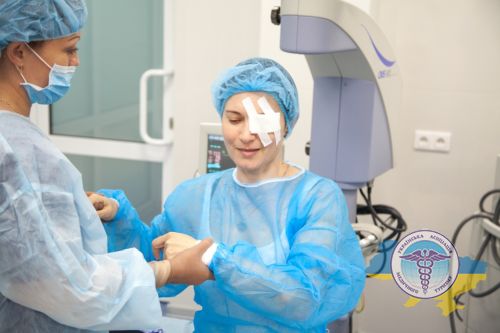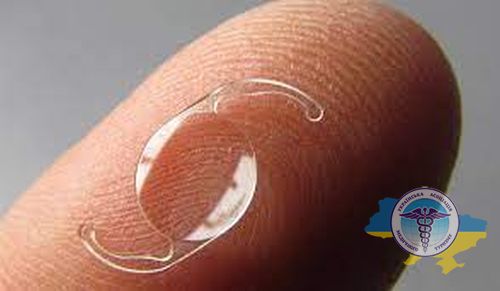Replacement of the lens of the eye in Ukraine

The lens in the part of visual system of the human body The function of lens is to refract light rays and project an image of objects onto the retina of the eye. A healthy lens is transparent. When the lens becomes clouded, vision deteriorates, loses its sharpness.
Another important property of the lens, along with transparency, is elasticity. This property allows a person to see equally well at different distances. Muscles that flex the lens tend to weaken and it loses its elasticity with age. The focusing ability of the lens decreases, such diseases as myopia and hyperopia occur.
Refractive replacement of the lens of the eye- a special ophthalmic-surgical operating method – allows to correct vision with such pathological changes.

Want to know how much the treatment costs?
Answer a few questions and get preliminary information about the cost of diagnosis and treatment!
When is eye lens replacement surgery necessary?
Operation of the lens of the eye replacement is indicated in such cases:
- Critical degree of myopia. Vision acquity -15 or worse (if the patient wishes to refuse vision correction with lenses / glasses);
- Critical degree of hyperopia. Vision acquity +6 or more (if the patient wishes to refuse vision correction with lenses / glasses);
- Hyperopia with a risk of glaucoma;
- Age-related decrease in visual acuity, accompanied by myopia (if the patient does not want to use glasses or lenses);
- High (6 or more diopters) degree of astigmatism;
- Cataract;
- Changing the shape of the lens;
- A sharp loss of elasticity by the lens (loss of refractive ability);
- Contraindications to laser correction;
- Afakia (lack of a lens due to injury or surgery).
How is the lens replacement carried out in clinics in Ukraine?

The procedure for replacing the lens with an intraocular prosthesis, the parameters of which are calculated during diagnostic examinations, takes about 20 minutes. The operation is performed on an outpatient basis. The patient goes home the same day.
In ophthalmological clinics in Ukraine, lens replacement is carried out in several stages:
- The patient is placed on the operating couch, after which the eye is fixed in the open state with a special device - a dilator. Such fixation is necessary to exclude involuntary blinking;
- The patient is given an injection of a local anesthetic;
- The ophthalmologist makes a micro-incision and performs the phacoemulsification procedure. During the procedure, an ultra-thin probe is inserted into the incision. By means of ultrasound, the lens is converted into an emulsion and is easily removed. An implant lens is installed in the lens bag.
Important! The procedure does not require suturing; after a while, the tissues at the site of the micro-incision will self-regenerate.
The sutureless technique makes the procedure safe. The possibility of developing postoperative complications is minimized. The patient does not feel any painful sensations either during the procedure or after its completion. Vision improves immediately after the end of the operation and recovers as much as possible in a few days.
Do you need rehabilitation after refractive lens replacement?
This ophthalmic operation does not require hospitalization. The recovery and rehabilitation period is short, there are no serious postoperative restrictions. After refractive lens replacement, the ophthalmologist examines the patient and gives all the necessary recommendations. For the recovery to be successful and fast, you must:
- avoid excessive eye strain, that is, alternate reading, writing (including using computers and smartphones) or watching TV with rest;
- do not rub your eyes;
- do not lift weights, avoid physical activity;
- do not visit saunas, baths, swimming pool;
- avoid sudden temperature changes, do not overcool;
- while outdoors, use sunglasses;
- do not abuse alcohol.
The restrictions must be observed for two weeks. Further, after a routine examination by an ophthalmologist, the patient can return to his usual routine. Sometimes the restrictions are extended for one to two weeks.
How to choose the type of artificial lens?

Before carrying out a refractive operation to replace the lens of the eye, the selection and calculation of the necessary parameters of an artificial lens is carried out. These parameters include: material, shape, elasticity, the ability to refract rays, the presence of special filters.
Modern ophthalmic equipment allows you to select the optimal lens characteristics, taking into account the structural features of the patient's eye. When choosing an implant, the patient's age and gender, his professional activities are also taken into account.
This approach allows you to choose an artificial lens, which will ensure the maximum possible restoration of visual acuity.
Let's consider the main types of artificial lenses that are used most often:
- Aspherical. A natural lens is never completely round, that is, it does not have an ideal spherical shape. Aspherical implants accurately reproduce the shape of the patient's lens, which allows maximum restoration of vision;
- Toric. Their feature is the ability not only to get rid of hyperopia or myopia, but also to correct astigmatism. These lenses have different surface curvatures in different areas, and, therefore, light is refracted with different strengths. Due to this, the eye can focus on objects, a clear image of the object is formed;
- Multifunctional. Recommended for patients aged 45-50 years. There are zones of increased optical power on the surface of the prostheses. Their presence allows the operated patients to see well both at short and long distances;
- Monofocal with yellow filter. Designed to correct myopia, that is, they provide good vision at long distances. The filter prevents the harmful effects of ultraviolet radiation on the eye. To correct myopia and other visual errors, it may be necessary to install special additional lenses;
- Phakic. Does not require removal of the natural lens. Placed in the anterior or posterior cavity of the lens capsule. Corrects astigmatism, myopia, hyperopia. They are also recommended if the laser correction procedure is not possible (there are contraindications);
- Pseudophakic (additional). Replacing the lens does not always restore vision to the desired degree. In this case, additional lenses are used, they are installed over the main implant and allow you to correct vision errors. They are also installed in case of a gradual deterioration of the effect of a previously implanted prosthesis.
Note! The type of artificial lens significantly affects the cost of the operation. In ophthalmic practice, spherical lenses are also used (with a surface without curvature). Such prostheses are less expensive, but they are not as effective and do not allow achieving the same result as all of the above types.
The cost of replacing the eye lens in Ukraine
As already mentioned, the lens-implant in each case is selected individually. A number of factors affect the price of an operation to replace the lens of the eye: the complexity of the case, the presence of concomitant diagnoses, the type and manufacturer of the prosthesis, and the extraction method.
Also, the cost of refractive lens replacement in Ukraine depends on the clinic in which the operation will be performed. The estimated cost of the procedure ranges from $ 800 to $ 2500 (depending on the type of lens and the specific ophthalmological center).
The operation is expensive, but its efficiency justifies the cost. Vision returns quickly, the risks of complications are minimal, there is no need for a long rehabilitation period, and the quality of life is significantly improved.



